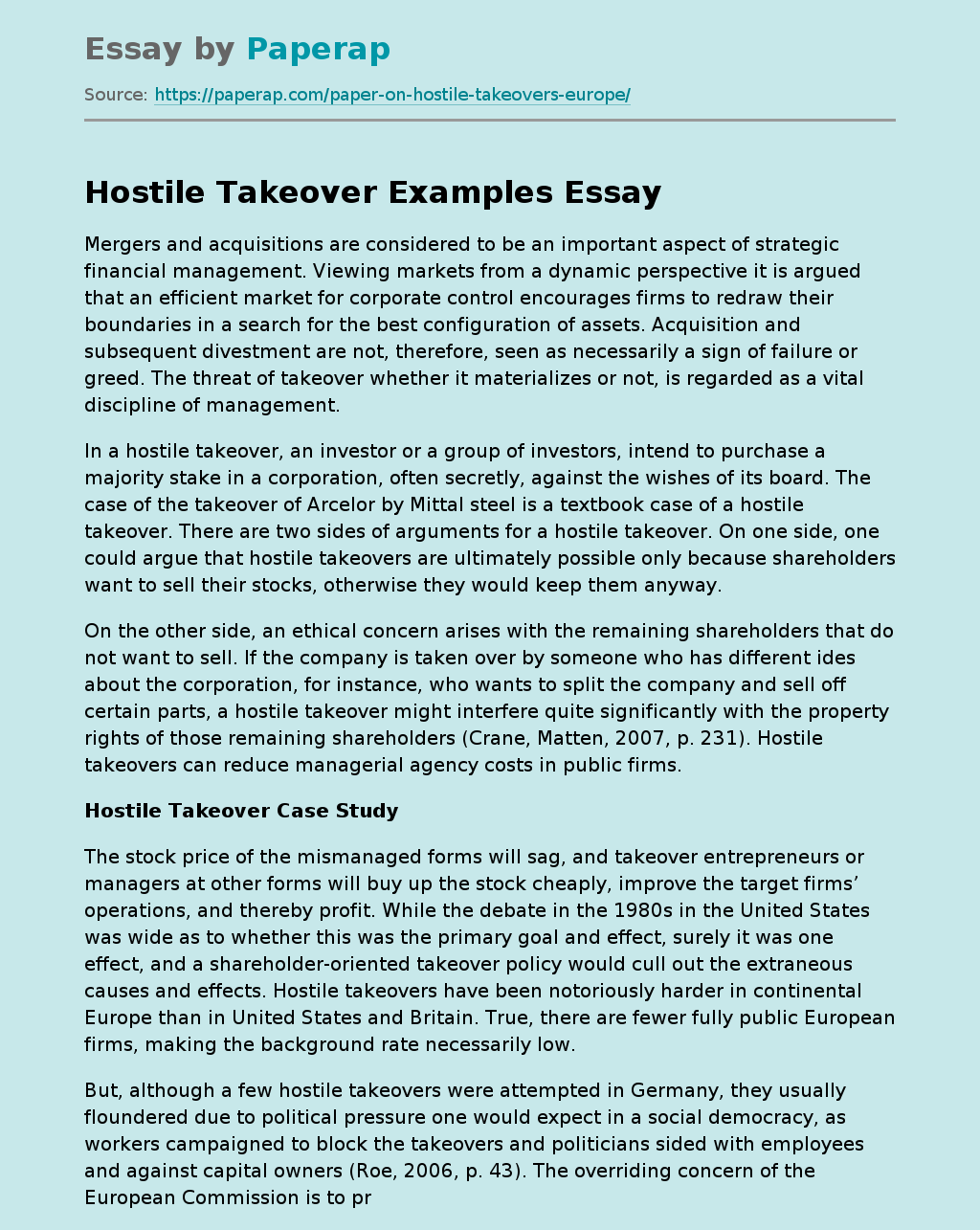Hostile Takeover Examples
Mergers and acquisitions are considered to be an important aspect of strategic financial management. Viewing markets from a dynamic perspective it is argued that an efficient market for corporate control encourages firms to redraw their boundaries in a search for the best configuration of assets. Acquisition and subsequent divestment are not, therefore, seen as necessarily a sign of failure or greed. The threat of takeover whether it materializes or not, is regarded as a vital discipline of management.
In a hostile takeover, an investor or a group of investors, intend to purchase a majority stake in a corporation, often secretly, against the wishes of its board.
The case of the takeover of Arcelor by Mittal steel is a textbook case of a hostile takeover. There are two sides of arguments for a hostile takeover. On one side, one could argue that hostile takeovers are ultimately possible only because shareholders want to sell their stocks, otherwise they would keep them anyway.
On the other side, an ethical concern arises with the remaining shareholders that do not want to sell.
If the company is taken over by someone who has different ides about the corporation, for instance, who wants to split the company and sell off certain parts, a hostile takeover might interfere quite significantly with the property rights of those remaining shareholders (Crane, Matten, 2007, p. 231). Hostile takeovers can reduce managerial agency costs in public firms.
Hostile Takeover Case Study
The stock price of the mismanaged forms will sag, and takeover entrepreneurs or managers at other forms will buy up the stock cheaply, improve the target firms’ operations, and thereby profit.
While the debate in the 1980s in the United States was wide as to whether this was the primary goal and effect, surely it was one effect, and a shareholder-oriented takeover policy would cull out the extraneous causes and effects. Hostile takeovers have been notoriously harder in continental Europe than in United States and Britain. True, there are fewer fully public European firms, making the background rate necessarily low.
But, although a few hostile takeovers were attempted in Germany, they usually floundered due to political pressure one would expect in a social democracy, as workers campaigned to block the takeovers and politicians sided with employees and against capital owners (Roe, 2006, p. 43). The overriding concern of the European Commission is to promote the restructuring of European industry. Even though there are large fluctuations over the time in individual countries, the general perception is that at least, during the 1970s and 1980s, the Untied States has been more successful in restructuring its industry.
A considerable share of this restructuring was achieved through hostile takeovers, and even when transactions were negotiated the potential for a hostile bid played an important role. However, within Europe, the hostile takeovers were confined primarily to he United Kingdom, Hostile takeovers, in the sense of tender offers launched in the market, have been very rare in Continental Europe, at least until very recently. For instance, in 1989, there were only four hostile takeovers in all the rest of EU15, compared to thirty two in United Kingdom.
This number was however equaled at 21 in the year 1999 (Huizinga, Jonung, 2005, p. 36). A number of features of the Continental European economies (i. e. Europe minus UK or non-UK regions of Europe) have been put forward to explain the differences in the level of their takeover activity. The takeover barriers are functionally similar to takeover defenses, in that they both help to entrench target management. Takeover barriers are common in Continental Europe, while takeover defenses are widely used in the United States, though in case of Arcelor-Mittal both are equally significant (de Menil, Portes, 2003, p. 78).
Many continental European countries have structural and/or regulatory barriers to takeover activity: control over voting rights, privileges granted to management to take actions without shareholder approval, and restrictions on shareholders access to information. These barriers are sufficient in some case to preclude takeover attempts. However, in general these barriers are increasingly being dismantled though gradually (Smith, 1994, p. 89). Also funds have been found to finance even the hostile takeover moves by local banks, as is seen in the case of the Societe Generale bank in the Arcelor-Mittal takeover.
This section will discuss the takeover barriers existing in Europe in detail, as they are applicable to the Arceor-Mittal case study. It must be noted here that many of the takeover barriers that are usually applicable for companies based in Continental Europe either did not matter or mattered very less in case of Arcelor, as will be seen in the discussions below. Takeover barriers can be broken down into structural and technical barriers. Structural barriers are part of the institutional setting such as the influence of banks, the ownership structure and the size of the equity market.
Technical barriers, on the other hand are part of each individual firm’s governance structure, as laid down in the corporate charter and allocating the powers among its constituencies i. e. shareholders, management, workers etc. Examples of such common technical barriers that are specifically aimed at frustrating hostile bids are restrictions on the transferability of shares and voting restrictions. Dual-class shares, pyramidal groups and cross-shareholdings are devices to separate ownership and control, thereby also providing against unfriendly acquisition attempts (de Menil, Portes, 2003, p. 78).
Hostile Takeover Examples. (2019, Dec 05). Retrieved from https://paperap.com/paper-on-hostile-takeovers-europe/

